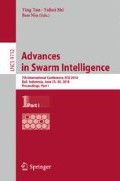Abstract
Swarming behaviour has been the subject of extensive objective analysis since Reynolds introduced the first-computer based ‘boids’ model in 1987. The current study extends that work by applying a range of measures — comprising existing and novel ‘group’ and ‘order’ measures and measures originally applied to chaotic systems — to a simplified version of Reynolds’ original boids model. Classifier models are then developed to identify preferred measures and combinations of measures that can accurately identify and quantify swarming behaviour. Novel combinations of existing measures show promise in providing a single measure to identify and quantify swarming. The results also suggest that there may be degrees of ‘swarminess’ rather than a simple swarming/not-swarming situation. Better understanding of swarming systems, including identifying measures that can define the parameter space in which swarming occurs and quantifying the resulting swarming dynamics, is potentially useful in a range of applications from targeted use of swarm intelligence systems to developing realistic graphics for visual effects. The predictive models developed in this study can be used as a basis for improving the predictability and tuning the behaviour of swarming systems.
Access this chapter
Tax calculation will be finalised at checkout
Purchases are for personal use only
References
Ding, M., Grebogi, C., Ott, E., Sauer, T., Yorke, J.A.: Plateau onset for correlation dimension: when does it occur? Phys. Rev. Lett. 70(25), 3872 (1993)
Ferrante, E., Turgut, A.E., Mathews, N., Birattari, M., Dorigo, M.: Flocking in stationary and non-stationary environments: a novel communication strategy for heading alignment. In: Schaefer, R., Cotta, C., Kołodziej, J., Rudolph, G. (eds.) PPSN XI. LNCS, vol. 6239, pp. 331–340. Springer, Heidelberg (2010)
Ferrante, E., Turgut, A.E., Stranieri, A., Pinciroli, C., Birattari, M., Dorigo, M.: A self-adaptive communication strategy for flocking in stationary and non-stationary environments. Nat. Comput. 13(2), 225–245 (2014). 1567-7818
Gazi, V., Passino, K.M.: Stability analysis of social foraging swarms. IEEE Trans. Syst. Man Cybern. Part B Cybern. 34(1), 539–557 (2004)
Grassberger, P., Procaccia, I.: Measuring the strangeness of strange attractors. Physica D 9, 189–208 (1983)
Harvey, J., Merrick, K., Abbass, H.A.: Application of chaos measures to a simplified boids flocking model. Swarm Intell. 9(1), 23–41 (2015). 1935-3812
Mecholsky, N.A., Ott, E., Antonsen, T.M., Guzdar, P.: Continuum modeling of the equilibrium and stability of animal flocks. Phys. D Nonlinear Phenom. 241(5), 472–480 (2012)
Pincus, S.M.: Approximate entropy as a measure of system complexity. Proc. Nat. Acad. Sci. 88(6), 2297–2301 (1991)
Reynolds, C.W.: Flocks, herds and schools: a distributed behavioral model. In: ACM SIGGRAPH Computer Graphics, vol. 21, pp. 25–34. ACM (1987)
Strömbom, D.: Collective motion from local attraction. J. Theor. Biol. 283(1), 145–151 (2011)
Strömbom, D.: Attraction based models of collective motion (2013)
Vicsek, T., Czirók, A., Ben-Jacob, E., Cohen, I., Shochet, O.: Novel type of phase transition in a system of self-driven particles. Phys. Rev. Lett. 75(6), 1226 (1995)
Vicsek, T., Zafeiris, A.: Collective motion. Phys. Rep. 517(3), 71–140 (2012)
Author information
Authors and Affiliations
Corresponding author
Editor information
Editors and Affiliations
Rights and permissions
Copyright information
© 2016 Springer International Publishing Switzerland
About this paper
Cite this paper
Harvey, J., Merrick, K., Abbass, H. (2016). Quantifying Swarming Behaviour. In: Tan, Y., Shi, Y., Niu, B. (eds) Advances in Swarm Intelligence. ICSI 2016. Lecture Notes in Computer Science(), vol 9712. Springer, Cham. https://doi.org/10.1007/978-3-319-41000-5_12
Download citation
DOI: https://doi.org/10.1007/978-3-319-41000-5_12
Published:
Publisher Name: Springer, Cham
Print ISBN: 978-3-319-40999-3
Online ISBN: 978-3-319-41000-5
eBook Packages: Computer ScienceComputer Science (R0)

